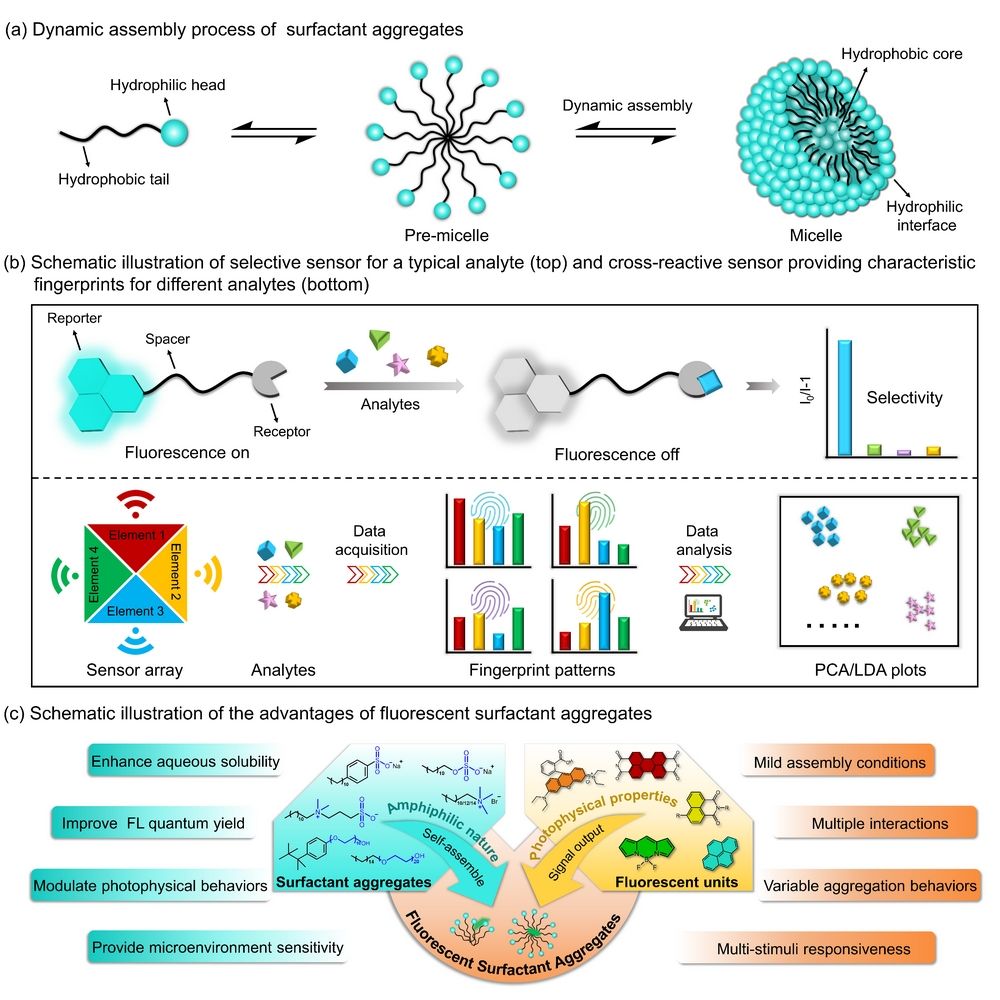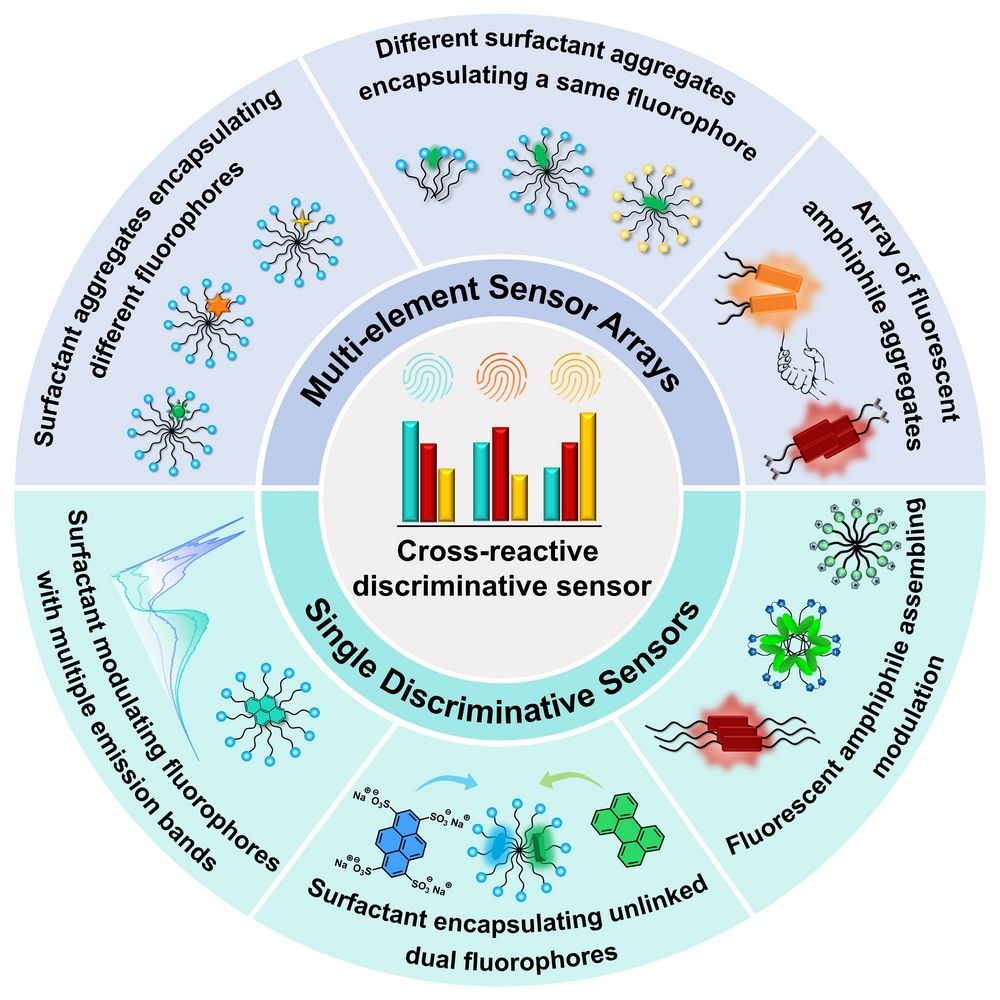
Zhen Yan, Min Qiao, Liping Ding* and Yu Fang. Curr. Opin. Colloid Interface Sci. 2024, 73:101831
Surfactant is characterized with amphiphilic molecular structure, containing a hydrophilic head group and a hydrophobic tail (Figure 1a). This endows surfactant molecules’ unique assembling behaviors in aqueous solution, where they can self-assemble into various colloidal aggregates, such as micelles, vesicles, and liposomes, etc. These colloidal aggregates are heterogeneous as having a hydrophobic core and a hydrophilic outer interface with water. Moreover, they are in dynamic assembling balance and are easy to be influenced by external stimuli like ionic strength, pH, and chemicals, etc. The heterogeneous microstructure of surfactant aggregates enables them to solubilize organic dyes in aqueous solutions and have been widely applied in fabrication of fluorescent chemo/biosensors Fluorescent sensors can be either selective or cross-reactive (Figure 1b). For the former kind, it usually contains a specific receptor structure for selectively binding and recognizing the target analyte among a variety of detecting samples. For the latter type, it is generally an array of a number of nonspecific sensor elements, where each sensor element responds to all the analytes with different extent of responses. The combination of output signals from all the sensor elements generates a specific recognition pattern to a particular analyte. Such fluorescent sensor arrays are known as “optical nose” or “optical tongue”, and can identify and differentiate multiple analytes through multivariate data analysis methods such as principal component analysis and linear discriminant analysis. Thus, cross-reactive fluorescent sensors can not only discriminate similar analytes but also analyze complex samples such as in biofluids or mixtures, which makes them more attractive in practical applications.
Surfactant aggregates have been widely applied in constructing fluorescent sensors as they can provide hydrophobic core to encapsulate fluorophores or co-assemble with fluorophores. Variety of advantages were accompanied with using surfactant aggregates (Figure 1c), e.g., increasing aqueous solubility of organic fluorophores, enhancing fluorescence stability and quantum yield of the encapsulated fluorophores, etc. Moreover, combining amphiphilic surfactant aggregates with fluorophores can not only retain the fluorescence properties, but also provide external stimuli sensitivity due to the dynamic assembling characteristics. Different surfactant aggregates and fluorophores can be flexibly selected and assembled to make the ensemble sensor system exhibit different structural/photophysical properties, which have the merits of multiple interactions, variable aggregation behaviors, mild assembly conditions and multi-stimuli responsiveness.
In this short review, we intent to systematically introduce the advances of surfactant aggregates in constructing cross-reactive fluorescent sensors and arrays, specially focusing on introducing different construction strategies based on using non-fluorescent surfactant aggregates and surfactant-like fluorescent amphiphiles (Figure 2). To generate sensor arrays, three ways were employed to vary the surfactant aggregate-based sensor elements: 1) use one particular surfactant aggregate to encapsulate different fluorophores to generate multiple sensor ensembles; 2) use different types of surfactant aggregates to encapsulate one particular probe to provide different sensor ensembles; 3) use different fluorescent amphiphile aggregates to offer multiple sensor elements. To build cross-reactive single-system-based sensors, there are also three ways that were attempted using surfactant aggregates: 1) ensembles with fluorophores exhibiting multiple emission bands; 2) encapsulation of two photophysical-related but unlinked fluorophores (FRET pair, D-A pair, etc.); 3) employing fluorescent amphiphile assemblies with multiple emission bands. Although surfactant assemblies have shown a variety of advantages in constructing cross-reactive fluorescent sensors and arrays, this methodology is still less developed and the roles of surfactant assemblies in the cross-reactive sensing is still less explored.
First Author: Yan Zhen, doctoral candidate, Shaanxi Normal University
Corresponding Author: Prof. Ding Liping, Shaanxi Normal University
Full Text Link: https://doi.org/10.1016/j.cocis.2024.101831

Figure 1 (a) A simple diagram depicting the dynamic assembly process of surfactant aggregates in aqueous solution. (b) Schematic illustration of selective sensor (fluorophore-spacer-receptor sensor) and sensor array (composed of a set of sensor elements). (c) Schematic illustration of the advantages of surfactant aggregates in generating fluorescent sensors.

Figure 2 Due to the heterogeneous microstructure and dynamic assembling nature, surfactant aggregates have been widely applied in constructing cross-reactive sensors and arrays through different strategies.
First Author: Yan Zhen, doctoral candidate, Shaanxi Normal University
Corresponding Author: Prof. Ding Liping, Shaanxi Normal University
Full Text Link: https://doi.org/10.1016/j.cocis.2024.101831